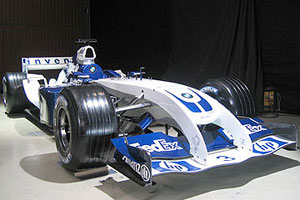JANUARY 5, 2004
The new Williams FW26 dissected

The new Williams-BMW FW26 is certainly rather different from some of the modern Formula 1 machinery and there is little doubt that the innovative design of the nose section of the car has come from the work of the team's aerodynamic department under former Ferrari engineer Dr Antonia Terzi, who joined the Williams team in the middle of 2002 and was involved in the development of the FW25. This time, however, Terzi had more freedom to be innovative and the result is very interesting. The car has a relatively short nose and rather than the traditional vertical mounting points for the front wing, the front wing assembly is attached to the nose by two sweeping planes, one on either side of the nose which curl over the rear part of the front wing, which is attached by two separate mounting points further back on the chassis. The effect of this is that the airflow is cleaned up much more than was previously the case and is then further compartmentalised by the use of the "twin-keel" layout under the nose. Cleaning up airflow means that the air is less disturbed (and therefore more efficient) further back in the car - and specifically around the rear wing. The channelling of the air means that the sidepods are not as wide as previously, which means that drag is probably reduced. The team is now keen to see how successful the new aeordynamics on the track, compared to in the windtunnel and the early launch of the car is designed to ensure that any problems are ironed out before the start of the new season in two months from now. "In 2003 it became evident that we suffered as a consequence of launching our car relatively late on in the winter," said chief operations engineer Sam Michael. "Refining the car took some time, and as a consequence of this we didn't win a race until Monaco, seven races into the year. The reason we are here unveiling the FW26 in order to bring our test programme forward really doesn't need any more explaining." The new regulations for 2004 mean that the engines are likely to be rather bigger and heavier than last year, to ensure that they last the required 800km. The BMW engineers in Munich have been working to minimise the loss of horsepower and maximise the reliability of the engines. The team has no new sponsors at the moment with the line-up, featuring Hewlett-Packard, Allianz, Budweiser, Castrol, Petrobras and NiQuitin CQ.